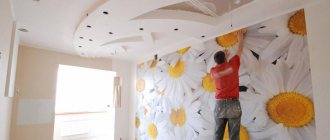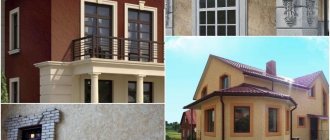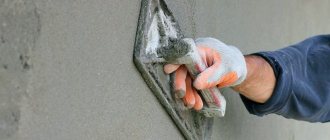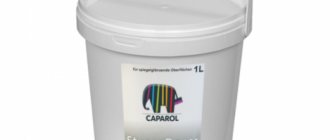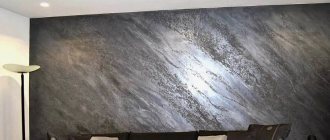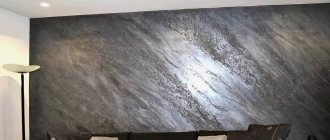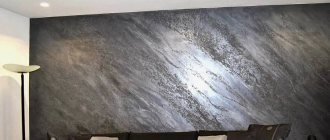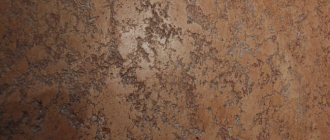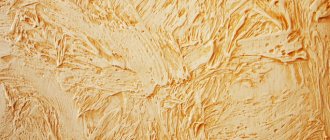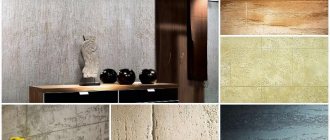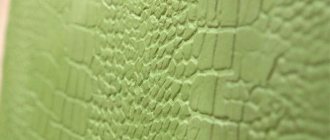Photo: kraski-net.ru Wallpaper has long been turning into a relic of the past, because it is being replaced by much more modern and practical materials. Today we will tell you about decorative plaster, its types, composition and how to apply textured material. Your walls will be smooth, textured and certainly unique!
Features and advantages of the material
The difference between ordinary and decorative plaster is the presence of additional impurities. Due to this, its surface is not smooth, but textured, and even with different patterns. It can even imitate other materials - stone, concrete, wood, fabric or suede.
Unlike wallpaper and painting, decorative plaster does not require perfect alignment of the walls. It just hides minor flaws and defects. For arches, cornices, niches and other complex shapes, there is no more convenient material.
The pattern of decorative plaster is always different, even if you work with the same mixture and tools. After drying, there are no joints or seams left, so the surface looks very neat. You can add pigments to the composition and tint it in any shade.
Preparation of walls before applying decorative plaster is minimal. The material itself is environmentally friendly, safe, does not emit harmful substances, does not absorb odors and does not change color. There are different series for indoor and outdoor use, for protection against moisture, fungus or aggressive environments.
Decorative plaster has almost no disadvantages. The main thing is to choose the right composition for a specific room and follow the application technique. And as a result, you will get a unique finish that no one else has.
PLASTER WITH CRACK EFFECT
Depending on the desired result, the application method is selected. You can create the appearance of paint that has cracked over time using a special varnish that cracks after drying. Professionals call this effect craquelure.
And global cracks and destruction in the wall can be created using a complex combination of plasters and properly selected lighting.
Types of plaster by composition
Technically, all types are similar: water base, filler and binders. But then the nuances begin, because some compositions are better suited for wet rooms, others for facades, and still others for living rooms.
Acrylic decorative plaster
A synthetic material based on acrylic resin is valued for its ability to repel moisture. Acrylic plaster is used in bathrooms and toilets. It has good adhesion, coverage and elasticity, and before use, the finished mixture from the jar can simply be stirred. But it can burn, so you should not combine acrylic plaster with flammable insulation or use it near fire sources.
Mineral decorative plaster
The mineral mixture is inexpensive and very durable, so it is still one of the most popular. It is best applied to mineral substrates with a quartz primer.
You can paint the finished coating on top or choose collections with interesting additives, such as sparkles or marble chips. In stores you will find this plaster in the form of a dry cement mixture, which is diluted with water before use.
Silicate decorative plaster
Silicate compounds are almost never used indoors. They contain potash glass, which is not very safe in closed rooms. Silicate plaster is available in ready-made form, sets quickly and is not easy to apply. But it is good for street work.
Silicone decorative plaster
Silicone series are definitely considered the most modern. It is elastic, durable, vapor-permeable and has high adhesion to any substrate.
Silicone plaster is often sold already tinted, so you can apply the coating right away and create interesting color transitions. But it costs more, and you need to buy a special silicone primer for it.
DIY decorative plaster: 8 ways to do it
Selection criteria for internal work
Its appearance and durability depend on the correct choice of decorative plaster. For interior spaces, there are a number of criteria, deviating from which is not recommended. First of all, you need to pay attention to what material the walls of the house are made of.
- For example, aerated concrete cannot be coated with mixtures that clog its pores. It must “breathe” accordingly; those plasters that are capable of allowing air to pass through are suitable for it. That is, a sand-concrete mixture will not work. But the mixture, which includes gypsum, can be used.
- Walls made of gas silicate blocks fall into the same category. Their structure also has air pores that cannot be clogged.
- For foam blocks, cement-based plaster is suitable, but with a low specific gravity and good adhesion.
- For wooden panels, plaster with an astringent sticky structure is used. In addition, it should include antiseptics to prevent wood rotting.
- If you need to plaster walls made of insulation, for example, penoplex, then it is best to use gypsum plaster. But you still need to apply it to a reinforcing mesh pre-fixed on the wall.
Important
In general, only silicate plaster, which contains substances hazardous to health, should not be used for interior spaces. Other types easily fit into the interior; you just need to think not only about the design, but also about the durability of the coating.
Types of material by texture
Decorative plasters differ not only in composition, but also in the type of coating. The relief after finishing can be expressed in different ways.
Textured
Textured plaster has a viscous structure and a large fraction, so it can mask large defects and uneven walls. Stone chips, pebbles, wood, mica and similar materials are used.
Almost no surface preparation is required before application, and the finished coating is very strong, hard and waterproof. Textured plaster is equally good for external and internal work. This category includes fur coat, bark beetle and other subspecies, the relief of which appears immediately.
Structural
Structural plaster has a finer composition and can be applied in a thin layer. Most often it has a silicate or acrylic base with marble and quartz chips. Different collections differ in grain and texture of the coating.
Structural plaster can be applied to mineral substrates, chipboard and plasterboard. It is not afraid of moisture, allows air to pass through well and dries quickly with virtually no odors. The finished wall is easy to clean and can even be washed.
Venetian
Venetian decorative plaster is the most uniform among all. The texture is created by fine marble chips and slaked lime. It is known that similar material was used by the ancient Romans when they mixed stone dust into finishing mixtures.
Externally, the coating is difficult to distinguish from natural marble or onyx, but it is difficult to apply. The required thin and light strokes and up to six layers on the wall, each of which needs to dry. Venetian plaster is quite expensive, but ideally complements classic interiors.
MDF: what is it? Types and features of material
What it is?
In terms of its composition, decorative plaster is practically no different from ordinary plaster. It also includes: cement, sand, lime. But the difference is the addition of additional granules, for example, wood fibers, pieces of mica, nylon fibers, etc. It is universal and has high ductility, with its help you can create any surface that will look like marble, wood, leather or silk. The range of this material is very wide - a large number of shades, types and textures. It not only looks beautiful and aesthetically pleasing, but also levels the surface of the walls, hides defects and fills microcracks.
Decorative plaster for interior wall decoration
How to apply decorative plaster
Clean the base from any decorative coatings, paint, or anything that may peel off. Get rid of greasy and dirty stains, construction dust and small fibers. Use regular putty and sealant to patch cracks, potholes and other defects, and dry.
Be sure to apply a primer that matches your type of plaster. It improves the adhesion of the finish to the wall so that in the future the plaster does not fall off in pieces. Use primers with beneficial additives, such as fungicides or antiseptics.
If you have a thin-layer and finely dispersed mixture, it is better to apply a leveling layer first. This is a traditional starting putty with a coarse filler like sand. Vary the number of layers depending on the situation, but be sure to dry everything and coat it with primer again.
Decorative plaster is applied with a spatula using wide strokes, directly or in an arc. You can create texture with a trowel by pressing it against the wet mortar and sharply pulling it back. It’s even easier to take a roller that already has the desired design applied to it. To give relief, various available materials are suitable - sponge, film, fabric, brushes, everything is used.
Methods of applying plaster
Main methods of applying the composition:
- With a roller . One layer of plaster is applied with a roller, thereby leaving the design;
- Stamps, stencils . Construction stores sell a large number of stamps and stencils “for brick”, “bark beetle”, “fur coat” and so on;
- Trowel . A small amount of the compound is applied to the tool and distributed in short bursts along the wall. Or, by applying pressure and tearing off the end trowel, a sharp relief can be achieved;
- Venetian style - two-color application technique . Involves plastering in two layers;
- Versailles reception . A dense layer of plaster is applied, which is then “smeared”. It is recommended to use white material, then paint it;
- With improvised means. You can use: a brush, a sponge, a newspaper, a nail, and so on.
Decorative plaster in the interior - photos and ideas
It is difficult to think of a situation, room or style for which it would not be possible to find a suitable collection of decorative plaster.
Furniture handles (70 photos): types, materials
Where and what type is used
Let's take a closer look at where and what type is best to use:
Mineral:
- For external work - yes;
- For interior work - yes;
- The base surface is any high-quality primer;
- Vapor permeability - high;
- Water absorption - high;
- Resistance to UV radiation - high;
- Resistance to dirt - average;
- Do not use indoors - without restrictions;
- Not resistant to vibrations, abrasion;
- Types of pigment - inorganic;
- Palette - medium;
- The cost is the cheapest.
Alkyd:
- For external work - yes;
- For interior work - yes;
- The base surface is any high-quality primer;
- Vapor permeability - low;
- Water absorption - low;
- Resistance to UV radiation is low;
- Resistance to pollution - low;
- Do not use indoors - bedroom, living room;
- Not resistant to fire;
- Types of pigment - organic, inorganic;
- The palette is rich;
- Cost - average;
- Note - elastic.
Silicone:
- For external work - yes;
- For interior work - yes;
- The base surface is any high-quality primer;
- Vapor permeability - high;
- Water absorption - high;
- Resistance to UV radiation - high;
- Resistance to pollution - very high;
- Do not use indoors - without restrictions;
- Not resistant to - no restrictions;
- Types of pigment - organic, inorganic;
- The palette is rich;
- Cost is the most expensive;
- Note - elastic.
Silicate:
- For external work - yes;
- For interior work - no;
- The base surface is a silicate primer;
- Vapor permeability - high;
- Water absorption - average;
- Resistance to UV radiation - high;
- Resistance to pollution - high;
- Do not use indoors - without restrictions;
- Not resistant to - vibrations;
- Types of pigment - inorganic;
- Palette - medium;
- Cost - average;
Flock:
- For external work - yes;
- For interior work - no;
- The base surface is any high-quality primer;
- Vapor permeability - low;
- Water absorption - low;
- Resistance to UV radiation is low;
- Resistance to pollution - low;
- Do not use indoors - without restrictions;
- Not resistant to fire;
- Types of pigment - no;
- The palette is rich;
- Cost - expensive;
- Note - elastic.
Caring for decorative coatings
Only 2 weeks after completion of work can the decorative plaster of the walls be washed. Walls with the effect of silk, velvet, corduroy and flock are washed with a soft cloth soaked in water. No brushes! The maximum is a sponge and a solution with soap. A soft brush for washing finishes with quartz filler, which is resistant to abrasion, is allowed. Wash the varnish or wax surface with a soft cloth using water, soap solution or dishwashing detergent. The Venetian is wiped with a damp soft cloth. Areas that are heavily soiled can be washed using a diluted soap solution.
Various types of decorative plasters have firmly taken their place in interior decoration; the coatings created have a number of amazing positive properties. When deciding to use such coatings, choose carefully and the result will not disappoint you.
